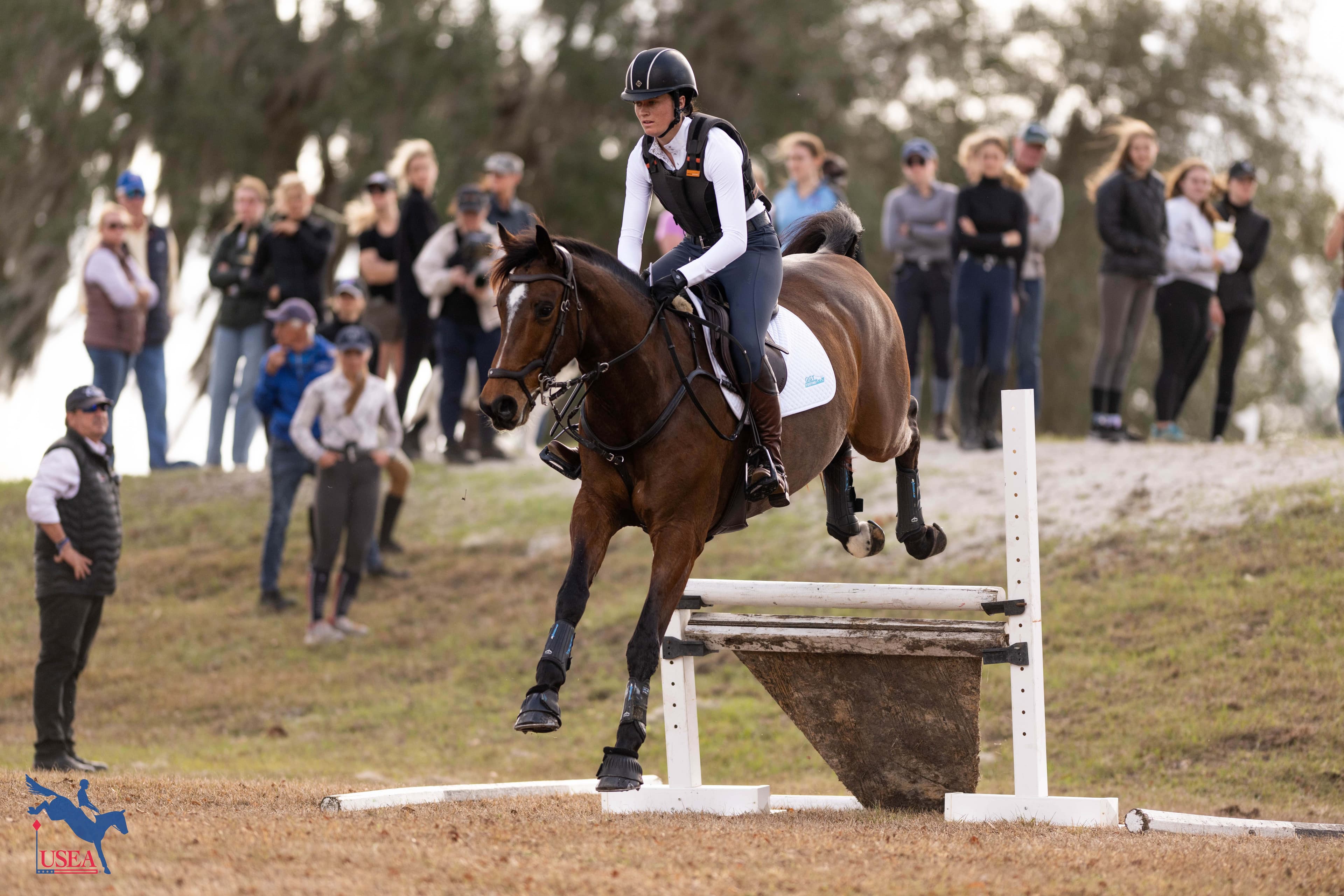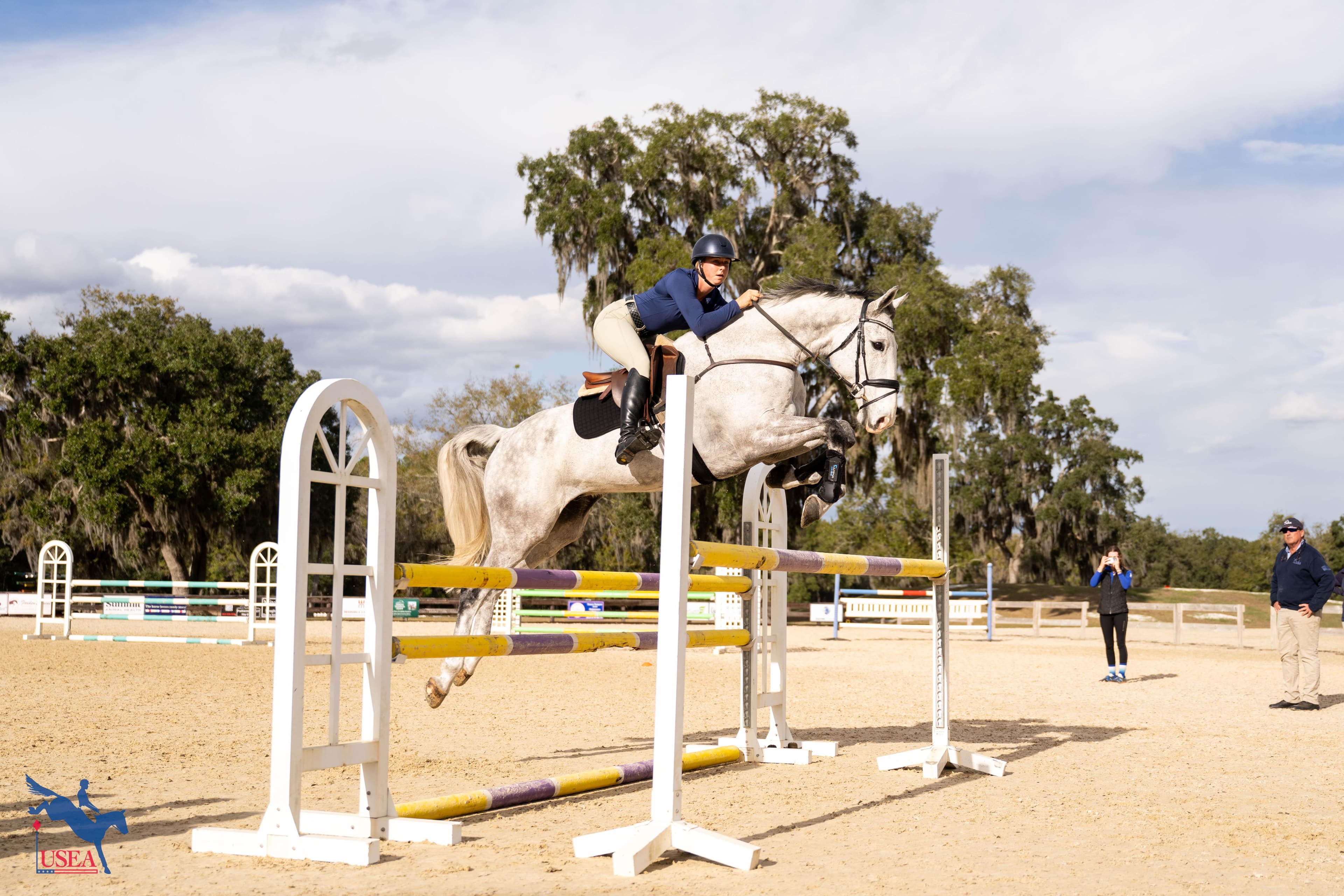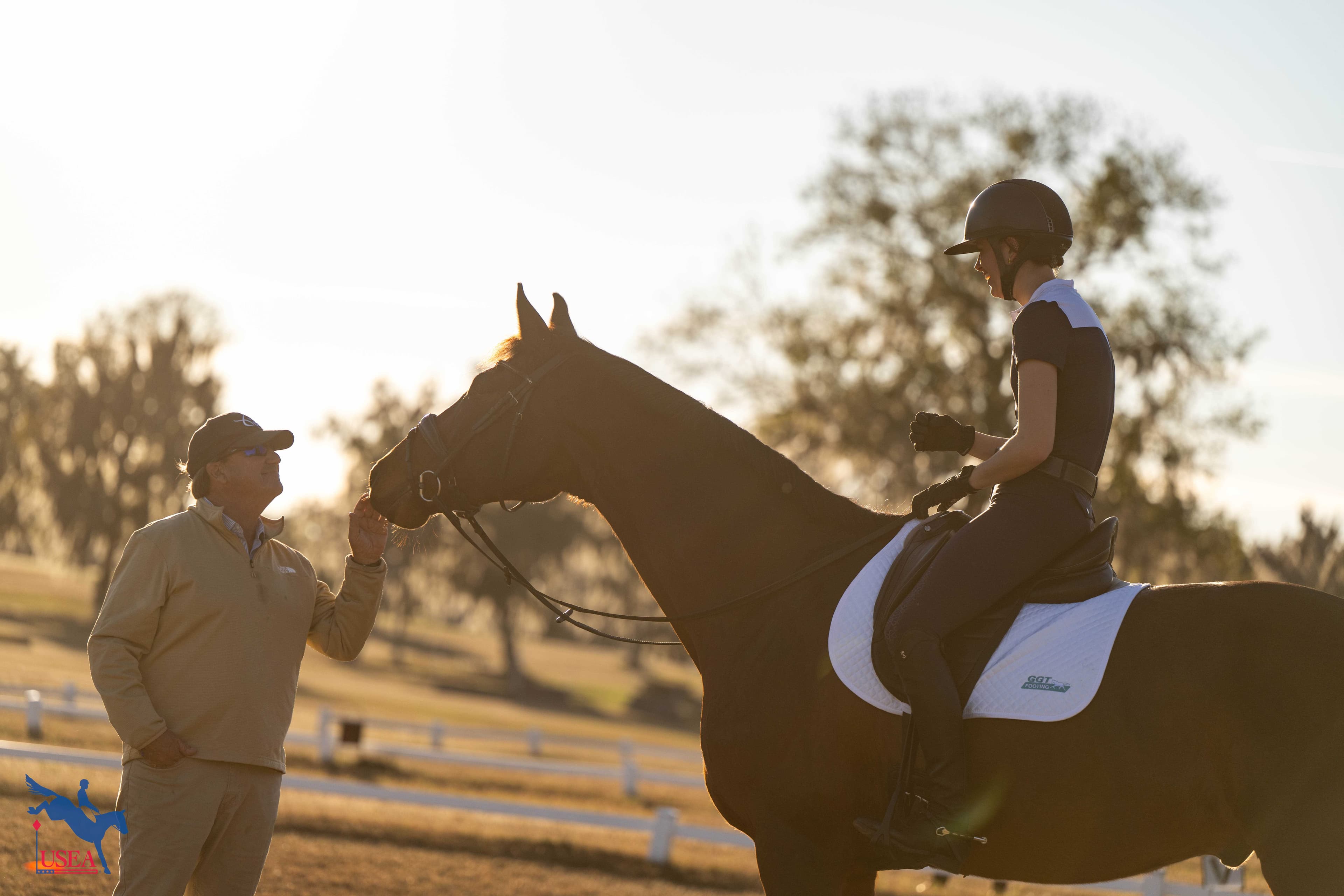Assessing an Unfamiliar Horse at the EA21 West Coast II Regional Clinic
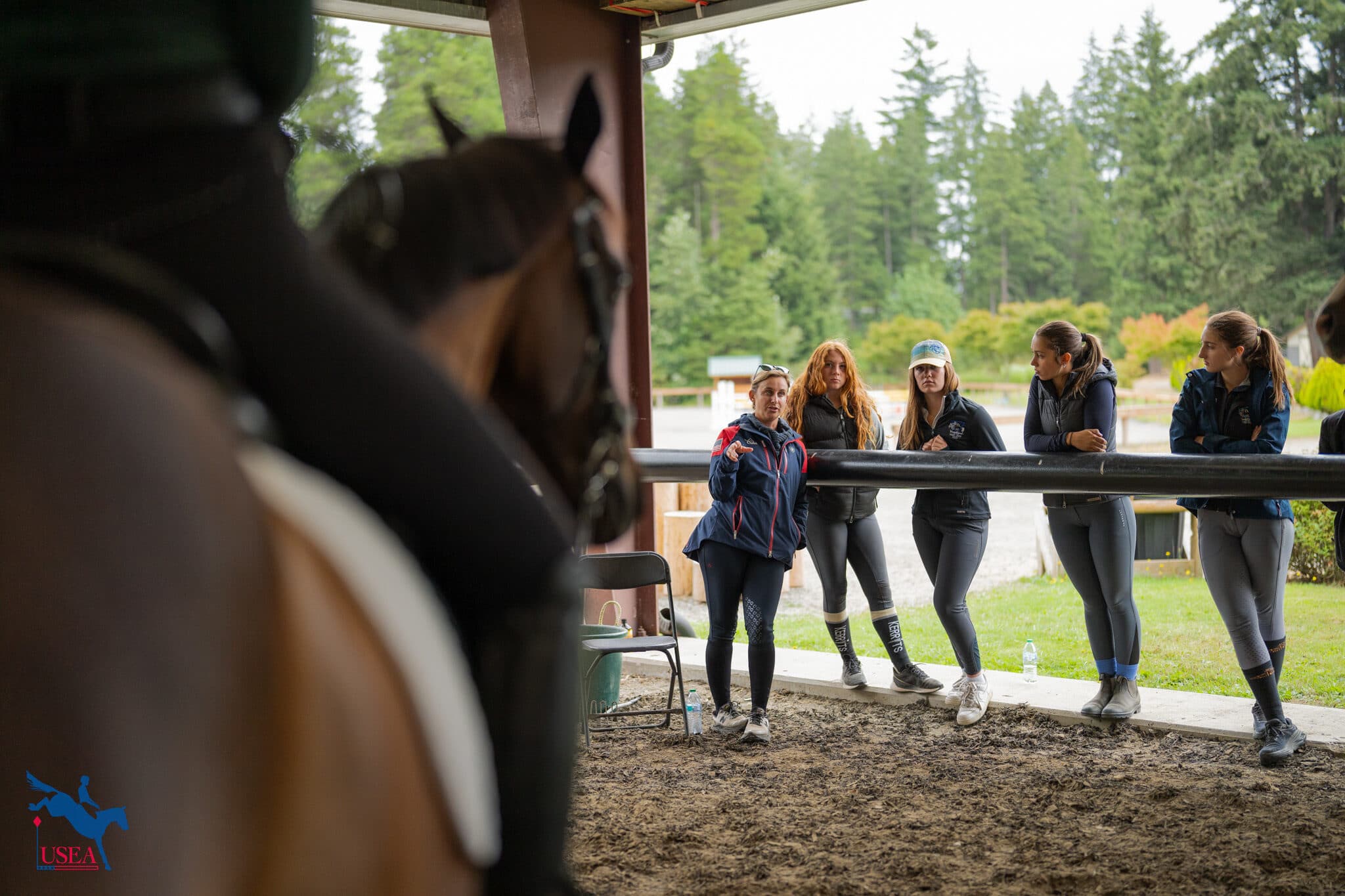
Yelm, Washington—Aug. 13— Catching riding was the theme of the first day of action at the 2024 USEA Emerging Athlete U21 (EA21) West Coast II Regional Clinic on Tuesday at Aspen Farms, a 240-acre facility in Yelm, Washington, about 60 miles south of Seattle.
Each of the six dressage sessions on Tuesday featured two riders who swapped horses, and then spent several minutes warming up and flatting their mounts, working through the various gaits and performing lateral work. For most of the six sessions, they would then stop for a quick conversation with Advanced level eventer and EA21 Coach Rebecca Brown about what they felt they needed to continue working on so they could then perform the 2022 USEF Preliminary Test A on their catch ride.
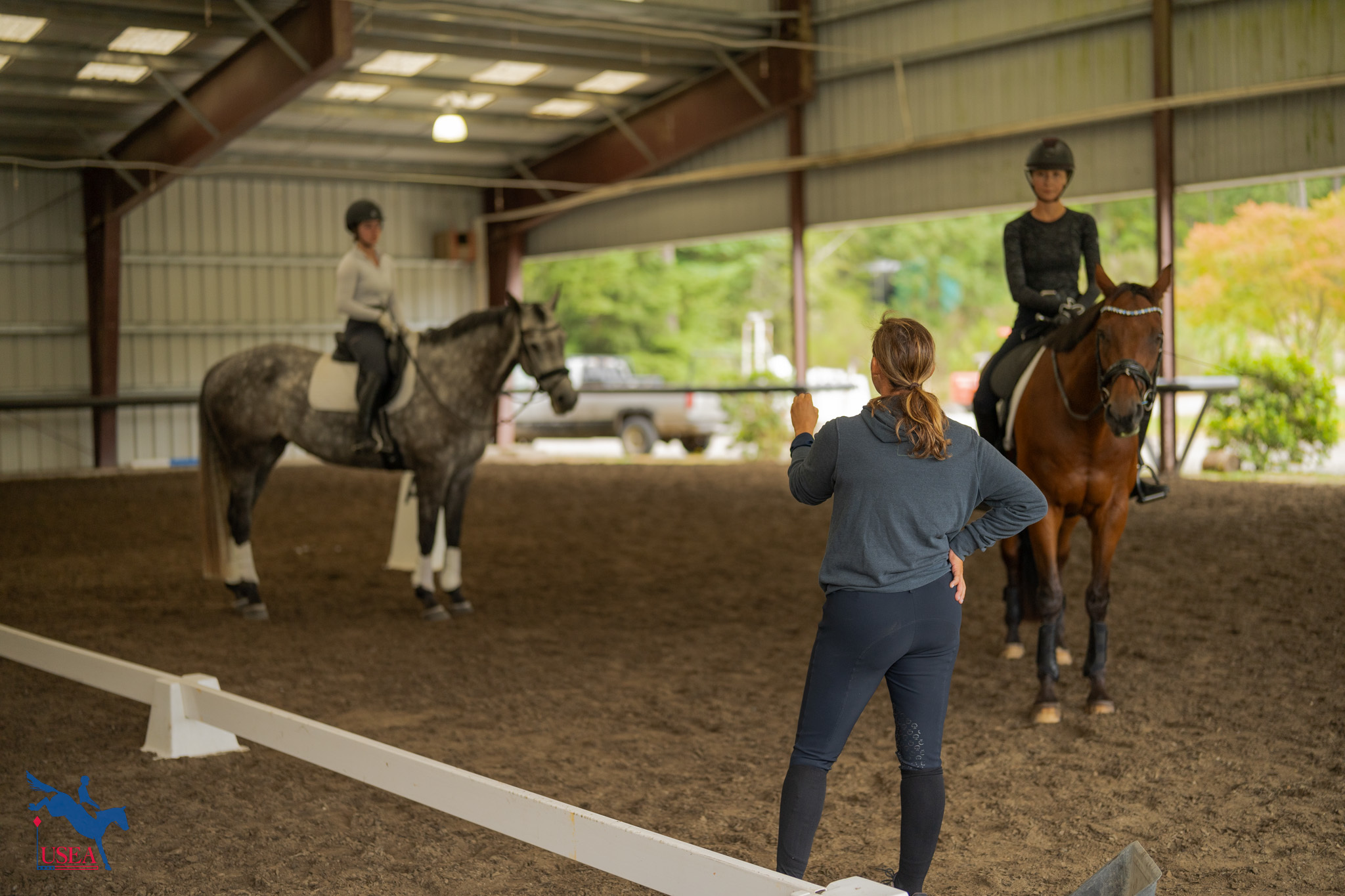
The morning’s first session featured McLaine Mangum, 18, of Redmond, Washington, and Hanni Sreenan, 18, from Hood River, Oregon. Mangum rode Sreenan’s three-star competition partner, 17-year-old Hanoverian gelding, Ebenholtz (Ehrentusch x Levantine). Sreenan rode Grantstown Mr. Big (Mr. Big Cat x Hollthill Grandpas Pet), Mangum’s 11-year-old Irish Sport Horse gelding with whom she competes at Preliminary.
It was during this first session that Brown reinforced another theme of the day: the German Training Scale (GTS). Brown said it’s pivotal for riders to know it and utilize it every time they ride and particularly when riding new horses. She first touched on the importance of the GTS in the short lecture she did Tuesday morning before the dressage sessions began.
“Everything, everything, everything is based on the German Training Scale,” she said. “Very few things in horses are black and white so anytime you can sink your teeth into something that is black and white, you go for it.”
The GTS is a phased system that helps a rider to evaluate how a horse is going and determine how to prioritize what to work on. The six facets of GTS are rhythm, relaxation, connection, impulsion, straightness, and collection. There are three phases in the GTS, and the facets overlap within those phases. Brown encouraged participants to run through the GTS as they worked their catch rides before performing the dressage test.
“If you have this memorized, and you’re on a horse and have issues, it’s a methodical way to go through it,” Brown said. “I feel horse riding is more mental than physical. Figuring out problems is really more mental than physical. And this just gives you a more clarified thought process.”
For Sreenan, Brown reinforced the straightness facet of the GTS, as Sreenan said “Biggie” didn’t want to move forward from her leg.
“What comes before impulsion in the training scale? Straightness. You’re really crooked,” Brown said. “This one is a killer. Everyone struggles with straightness. Everything has to follow the head, and straightness is one of those things you have to work on forever.”
In third session, Shruti Bona, 19, of Duvall, Washington, rode Independer JWB (Zavall VDL x Operette), an 11-year-old British Sport Horse gelding with whom Kendal Smith, 19, of Sammamish, Washington competes at the Preliminary level. In a few weeks, Smith is headed to the University of Kentucky, where she’ll study and ride for the equestrian team.
In Tuesday’s EA21 session, she rode SRF Western Territory (Beaulieu's Quissini x Jetting West), a 10-year-old Selle Français mare that Bona borrowed to attend the EA21 clinic.
After Bona and Smith warmed up “Indie” and “Sandy”, they discussed with Brown what each felt needed work. Bona said she liked Indie’s rhythm but wanted to stay steady with her contact so he’d be responsive and respectful of her leg. Meanwhile, Smith said she felt Sandy tended to get “a little quick.”
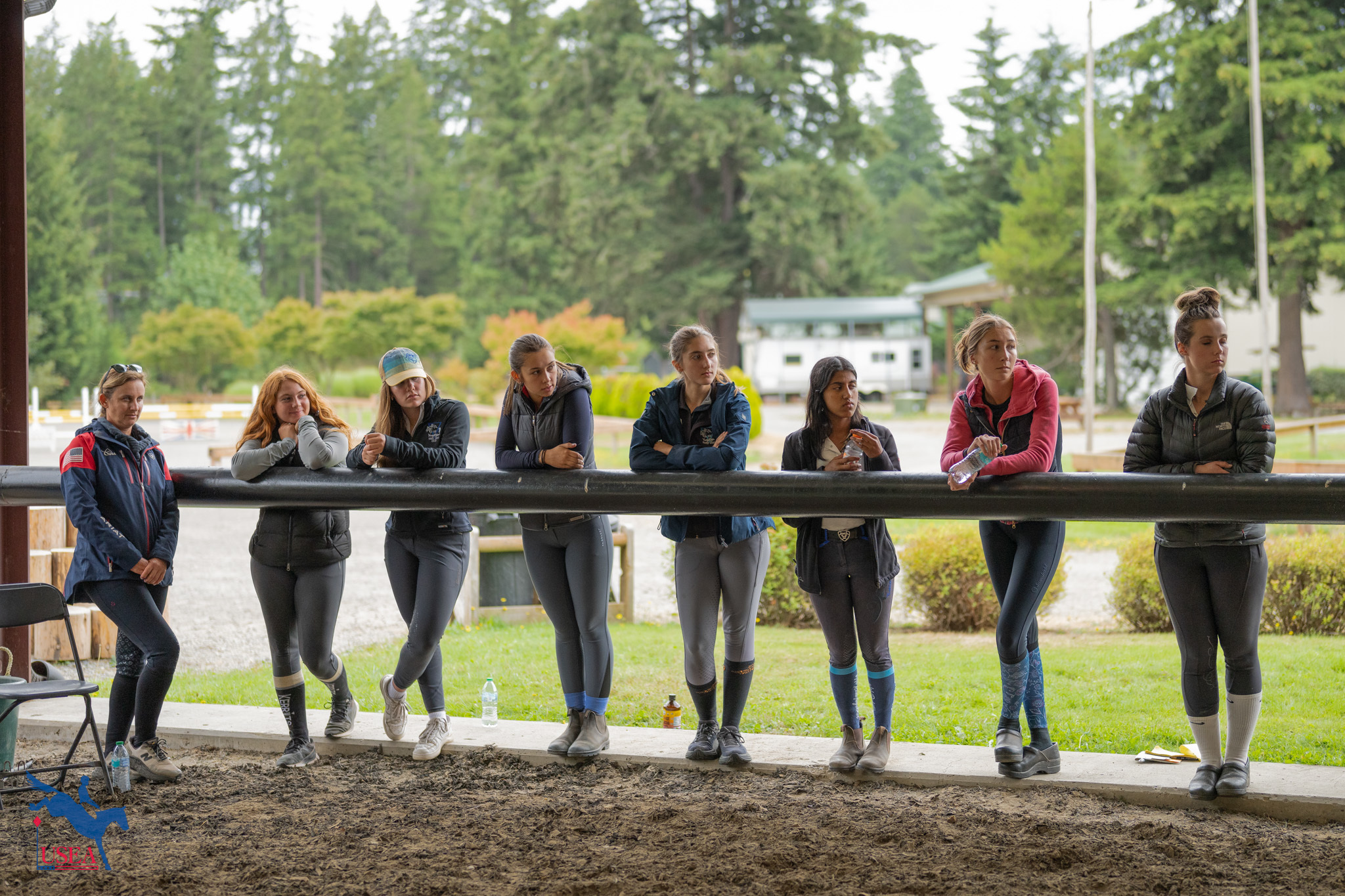
Brown suggested to both that before getting on a new horse, they study the horse’s confirmation for indicators of how the horse might go. Additionally, they both need to keep their reins from getting too long and ensure their arms stay “elastic,” she said. “Your connection in your hand is really from your elbow. You’ve got to keep your elbows elastic every step of the way.”
Next up were Kaylee Petticord, 19, of Enumclaw, Washington, and Ella Eisenbarth, 17, of Woodinville, Washington. Both ride at the Preliminary level with their horses. While the two warmed up their respective mounts, Brown talked with the participants who were watching from the ground about the importance of catch riding. At her Texas training operation, RB Riding, she’s instituted “Catch Ride December” where she encourages all of her students to ride as many other horses as they can. She emphasized how important it is for EA21 participants, too.
“You can learn something from every single horse,” she said. “Sometimes it’s a positive learning experience and sometimes, I don’t want to say a negative learning experience, but maybe it’s just ‘I don’t like this about this horse.’ The next step is you have to figure out how to fix it.”
Brown pointed to collegiate equestrian competitors who routinely randomly draw horses and then have to compete on them after a short warm-up period. She said a goal of the EA21 is to help riders be successful on any horse they ride.
“There are those riders who literally are winning Grand Prix on the weekends but then can’t put a test together. There are some people who are really good but only with their own horse,” she said. “That’s the point of this program. We want you to be good on a lot of horses. It’s very educational. You get a fresh take on a new horse. When you’re on a new horse, you really have to cling to theoretical knowledge.”
For Petticord and Eisenbarth’s session, the focus was on straightness, ensuring they correctly use corners, and using the shoulder-fore position.
“Stare at the [horse’s] head, Kaylee. I want you to always know where the head is positioned. You need to get into the corner to better finish your sentence,” Brown said of Petticord’s mount, Magic Mike, a 7-year-old Dutch warmblood gelding that Eisenbarth plans to move up to the two-star level this fall. “You need to stare at the head and stay in the moment.”
When Eisenbarth’s mount, All That Jazz, an 11-year-old off-track Thoroughbred mare that Petticord competes at the two-star level, jigged during the medium and free walks, Brown recommended using a distraction.
“If you have a horse that anticipates the walk, I would do a walk but make it different than what the test [asks for], and I’d go slow and put their nose in the dirt,” she said. “Ella, you need to keep the rhythm in your seat. When they get like that, you feel like you’ve got to go quiet, but you actually need to keep the rhythm with your seat.”
After a short lunch break, the fifth group started. It included Padgett, 16, of Woodinville, Washington, and Caterina Ritson, also 16, of Ridgefield, Washington. Padgett piloted Ritson’s This Lad is Gold (Private Gold x This Ones a Riot), a 16-year-old Thoroughbred who’s moving up to Intermediate in September, while Ritson rode Captivate (Cunningham x Dorothy’s Cabin), a 13-year-old Holsteiner-Thoroughbred cross who competes at the three-star level.
The two teens started out on each other’s horses and then swapped back to their own mounts so they could apply what they’d gleaned from their catch rides to their own horses.
“Today was really seeing how the basics play into the upper-level movements of dressage,” Ritson said. “It was really helpful to be able to work on my position and how my position affects my horse, and then take the skills from the other horse and apply it to my horse.”
The day’s final session featured Simone Clark, 17, from Seattle, riding Olivia Keye’s Chromatic Flyer, a 12-year-old Thoroughbred gelding who Keye competes at the two-star level. Meanwhile, Keye, who hails from Kalispell, Montana, rode Clark’s 12-year-old Trakehner mare, Sunsprite Seryndipity (Steinburg x Symplicity), who competes at the Preliminary level.
After the teens rode each other’s horses, they swapped back to their own mounts. Brown recommended that Keye use the time on “Alvin” to push the limits of working with him to move forward.
“You’re not at a show. Be a little brave and have a moment or two of mistake making,” Brown said. “You have to be brave. I know a little of that feels messy, but you have to be working toward that. You keep him a little conservative. You have to push him there. It’s better to make more mistakes in terms of the big picture of training than to hold them together.”
Wednesday’s action gets underway with a 7:30 a.m. lecture followed by four jumping sessions with three participants in each. Participants will ride their own horses for the jumping sessions, where the focus will be on technical questions, such as those riders might encounter on cross country, but using stadium jumps.
“I’m pretty excited about tomorrow,” said Bona, a first-time participant in the EA21. “Sandy is a two-star horse, but I’m excited to stick at the Training height and really enjoy her. She’s a beast to jump. She’s so game, and she wants so badly to do everything really, really well. It’ll be nice to go around and do a course and hear Rebecca’s feedback on the more technical things.”
Gabbrielle Curtis agreed.
“I think his favorite phase is cross-country, and just jumping,” she said of her horse Sur. “I’m hoping it’ll be educational, because there have been a lot of ups and down for us this season. Hopefully it’ll help with some of the issues we’ve been having.”
The Participants:
- Shruti Bona
- Simone Clark
- Gabrielle Curtis
- Ella Eisenbarth
- Olivia Keye
- McLaine Mangum
- Harper Padgett
- Kaylee Petticord
- Abigail Popa
- Caterina Ritson
- Kendal Smith
- Hanni Sreenan
Don't forget to follow the USEA’s coverage on social media!
Facebook | Instagram | Twitter
About the USEA Emerging Athlete U21 Program (EA21)
The purpose of the USEA Emerging Athletes U21 Program (EA21) is to identify and provide consistent quality instruction to the next generation of elite event riders. The aim is to create a pipeline for potential team riders by identifying and developing young talent, improving horsemanship and riding skills, and training and improving skills and consistency.
The USEA Emerging Athletes U21 Program was launched in 2022 with a model of five summertime regional clinics taught by selected USEA Eventing Coaches Program (ECP) instructors, leading to a winter national camp consisting of selected Young Riders from the regional clinics. Athletes who are 21 years or younger, are current members of their USEA Young Rider Area program, and are established at the Training Level or higher, are eligible to apply for the EA21 program. Click here to learn more about the USEA EA21 Program.
The USEA would like to thank ARMA, Kerrits, PulseVet, Ride iQ, Sidelines Magazine, Schneiders Saddlery and #WeRideTogetherfor sponsoring the USEA Emerging Athletes U21 Program.

